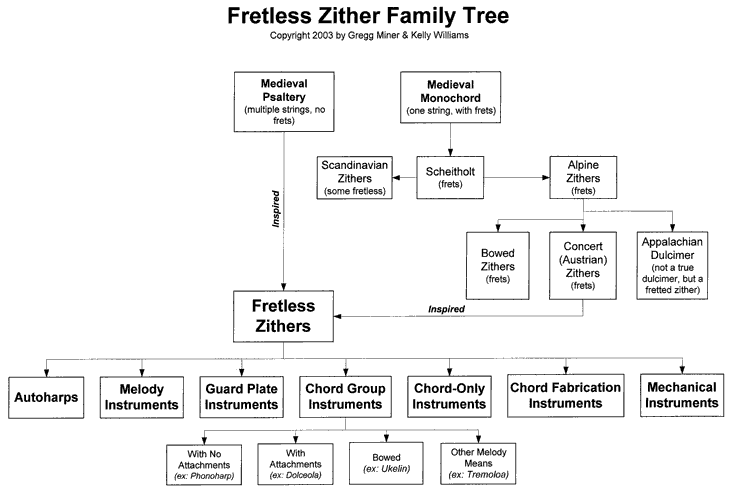Selecting the Term
The
authors have long been involved with the collection, study, discussion and
presentation of these instruments, and had previously worked independently
on terminology. Only by joint discussion and collation of all the existing
classification by others (right or wrong) were we able to finally
determine the best and most optimal term.
Miner
had originally used the term American "zither" -
inspired by a Frets Magazine writer. "American" because the
instruments proliferated in the U.S. and to differentiate them from the
concert zither form (historically originating from and traditional to
Austria/Germany); "zither" in quotes to imply that it was an
improper term (i.e: not a “true” zither). The appellation is confusing
in many ways. Similar instruments were simultaneously made in European
countries; the use of quotes around "zither" is not understood;
and "American" was mistakenly taken to mean any zither
manufactured in America (such as a Schwarzer concert zither). We now deem
it inappropriate in any context.
Williams
has previously used the term Guitar Zither - as this is the
name chosen by the first inventor of the most common form (Menzenhauer's
Guitar-Zither). Also, it remained the most commonly used term in Germany
from 1894 to 1940 (both as a model name and form term). Unfortunately,
Menzenhauer couldn't have chosen a more misleading name for his
instrument. What he found "guitar-like" about his instrument is
anyone's guess. Indeed, today this term is just as frequently mis-applied
to the concert zither, which actually has a guitar-like
feature - the fretboard! Additionally, "guitar zither" never
covered the many other common forms of fretless zither. Therefore,
"Guitar Zither" should only be used to refer to that specific
Menzenhauer model.
European
scholars, such as England's redoubtable Anthony Baines, later used the
term chord zither, introduced in his 1992 The Oxford
Companion to Musical Instruments. It seems intended only to cover the
basic "chord group" zithers. Perhaps he borrowed the term from
Sibyl Marcuse, who used it to refer to the Autoharp in her 1975 A
Survey of Musical Instruments. Ironically, Baines had earlier used the
term fretless zither in his landmark 1966 book European &
American Musical Instruments - under the Psalteries and Dulcimers
section (which makes sense) - using it to cover both Autoharps and various
types of what we are now classifying as fretless zithers. However, he
never used it again (The Oxford Companion listing "chord zither"
and "Auto-harp" as separate entries). Thus, by their own
confusion and term-swapping, the scholars themselves show the term
"chord zither" to be completely inappropriate. It has never been
defined as to which exact forms, styles or models of fretless zithers it
is meant to cover. Sometimes it is intended to cover the "chord
group" category of fretless zithers, other times the Autoharp
and its relatives. The latter actually makes more sense as they are
more prominently "chord-producing" instruments; while the
"chord group" instruments almost always have a prominent melody
bank in addition to chords. In the end, of what clear and meaningful
descriptive value has the word "chord"? None.
We advocate discontinuing any future use of this term.
Griffbrettlose
Zithern.
It took German zither researcher Andreas Michel to remind us of the
obvious. In his work Zithern: Musikinstrumente zwischen und
Burgerlichkeit, published in 1995 and later repeated on the Internet here,
he discusses the mainly German versions of what he classifies as
griffbrettlose zithern. When
we accurately translated the term, it turned out to be, literally, "fingerboardless
zithers" (or, as Cary Karp would later interpret as "fretboardless").
We chose the equally accurate and descriptive English
word "fretless" (a term commonly understood today) - which we wholeheartedly embraced as the more obvious, elocution-friendly appellation. Ergo, "fretless
zithers."
We may present occasional points of disagreement with
Michel's conclusions or
terminology (most minor, and some possibly due just to translation
errors).
Michel
lists three categories of fretless zither:
"a)
Fret[board]less
zithers with chromatic or diatonic strings from low
to high (one or two courses);
b) Fret[board]less
with strings set in chords without melody
strings (which allow only chords to be played);
c) A combination of these (a and b), so having single melody strings,
accompanied by five to seven chords of strings together (usually four
chords on American models, though 3 and 5 are common - GM/KW). This allowed the melody to be
played with some limited accompaniment."
These
equate to the "Melody," "Chord-Only," (see Note
3
below)
and "Chord Group," forms on our Family Tree. In addition, we add
the remaining categories to the tree, then break these down further (below)
to cover the incredible amount of variations found in America. A partial
list, containing over 75 manufacturers and over 100
of their prolific names is posted on Williams' site here.
All of these can (and should) be classified as fretless zithers.
The
sooner the thousands of collectors, players, researchers, music stores and
eBay sellers start using this term, the better off we'll all be. Of
course, when decals or labels are still present on instruments, their
specific "brand name" should be used with the other descriptors
(e.g. "The Marxophone, a common fretless zither of the chord
group variety with attachments").
|


